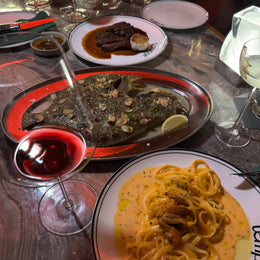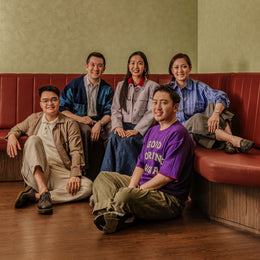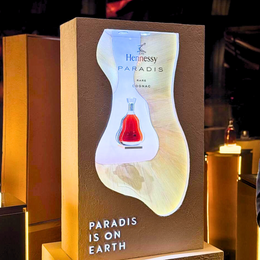
It's Cherry Blossom Season and Singapore's Sake Matsuri is upon us! While we don't have those lovely sakura boulevards, the spirit is still very much alive this April as we headed down to the heart of town for the all you can drink sake festival.
As someone just getting into sakes, I've always thought it was fairly daunting to pick out a whole bottle from one of those well-stocked fridges at Japanese supermarkets and even at restaurants, I'd usually just take the house's recommendations but it's always been pretty hit or miss. The last thing you want is to commit to a whole bottle you don't like or try something great but can't ever find it again.
All the while that makes it difficult to figure out what kind of sakes I actually like and also what sakes even have to offer - surely there must be more than the usual steamed rice and melon notes.
When the early bird offer rolled around for the Sake Matsuri festival, I figured $45 SGD (or US$33) for all you can drink sake sounded like a pretty damn good deal.

And so here we are, on a balmy Sunday at the open-air festival!

When we first got there, there were rolls of stalls lined up and it wasn't too crowded as we got there alittle early - we figured it'll probably get more crowded later.
Where should we begin; we decided to walk around and check out what's available, come along and check it out with us.

Lots of bottles, all chilled. A pretty good idea given the balmy weather. I'd love to be one of these bottles sitting pretty in the tub.

Each vendor brought along a whole range of sakes they typically offer at their website or restaurant but we'll get to try them today and if we like them we can buy a bottle back.
I've heard so much about Mirai Sake Hall, the food is said to be really good and the sakes solid picks and at good prices as well.

So many bottles to try, they're all chilled in tubs to keep them fresh, and lots of these stalls have write ups so you can read about the sake and it's back story, which is always something I appreciate. Helps me better understand what I should expect and it's always cool if it has some interesting story as well - belonging to some samurai or sorts.

I started off with this Kokki set that I got to try the full range of - they each are made with different yeasts so you get to taste how each expression is influenced accordingly. What's interesting was that it really stretched the same rice in different directions - some got alot brighter and fruitier, some richer and more umami. Very cool!

More sakes in tubs I wish I was in.

There's lots of interesting Japanese trinkets as well which you can buy back as gifts. Safe to say, I ended up taking some home, lucky friends I have.

I also tried this label called the IROOTOKO or "Lady Killer" from Watanabe Shuzo. So interestingly, this was created for a male hostess of a lady's club and he wanted a sake that would match the elegance of champagne and suited for his female clients' palate.
Well, I'm not female but I really enjoyed the sake - it was really bright and fruity with creamy sweet yogurt. Interestingly, the queue to try this was 50/50 male to female. So really "People Killer"?

What better a way to figure out what style of sake you like than attending a festival - we got a free wine glass as well. For some reason, I find the wine glass better for enjoying sake than the traditional small Japanese ceramic cups.
It allows me to swirl and check out the texture and the aromas are also more prominent.

I've never tried so many Junmai Daiginjo's in my life as I have today, and I've got to say, these are a whole other level in terms of complexity.
This Imanishiki Junmai Daiginjo was nifty - it's brewed using a relatively rarer varietal of "Miyamanishiki". There's always alot of flex about the use of Yamadanishiki rice, it's always touted as the King of Sake rice varietal, but its pretty interesting to get to try other lesser used varietals which often leads to completely different profiles.
This had lots of white florals and white peaches, it sort of reminds me of jasmine green tea but peach flavoured. It has nice estery notes of tinned lychees as well, and had a nice crisp finish.

I was very much looking forward to trying this entire set of Sakari sake ever since I first chanced about it - Sakari is a new refreshed line from Nihonsakari, which was known for providing its sake to the Imperial Household and was even supplied for the coronation ceremony of Japan's Emperor in the 1910's.
Till this day, Nihonsakari continues to be one of only four sakes that hold a royal warrant.
It's really cool that I'm getting to try the entire line-up at the festival, side-by-side.
Having tried them, I concluded that most enjoyed the Junmai Daiginjo which had a good balance between fruity flavours and depth, while the Junmai was too delicate and light, and the Daiginjo was alittle too heavy. The Junmai Ginjo was pretty tasty as well but with alittle less finesse.

All throughout the festival, the good folks helping out at the various stalls were extremely welcoming and nice and they're always happy to give you a refill and really kept their smiles and energy up despite the hot day!
They're also really quick to give you details about whichever sakes their representing which I really appreciated just how friendly and chill they were. No pushiness, they were just really nice - underrated but definitely something I appreciated.

Another brewery I really was hoping to try and got lucky that happened to showcase at the festival was Daishichi! This brewery is supposedly more traditional in using a Kimoto-style of brewing which means they take three times as long to make their sakes because they make their fermentation starters from scratch rather than add in industrial/commercial starters.
Sakes require the use of starters much like bread-making because the starch in rice grains needs to be first converted into sugar before it can be fermented into sake. It's why the rice needs to be polished to help cut to the core of the rice (that's called the shinpaku!) which is where the starch is at!
But it's one thing to read about it, it's another to get to actually try it - and boy, did it not disappoint.
The Daishichi sakes were really hefty and creamy with lots of intense fruitiness that came out and also had a light nuttiness to it that was really enjoyable.

I got to try several Daishichi sakes but the ones that stood out were the Masakura and the Minowamon! The Masakura was just fantastic - with really nice balance, while the Minowamon was more intense.
It's really cool to see the effects of the Kimoto-method play out in how the sakes taste.

More swirling... its so cool to get to try out a huge variety of flavors whether its from different yeasts used, rice varietals, brewing styles. It's one thing to read about it, its a whole other to get to try it for yourself side by side.

After guzzling so much sake, it felt like it was time to refuel, and thankfully there's several food stands. The oysters and mussels went particularly well with the sake and we got down to sitting at the benches to sip some more sakes while we totalled several bowls of the mussels and oyster platters.

Wagatomo restaurant, a Japanese restaurant right at the festival also provided some Japanese foods in convenient takeaway boxes. It was really good to have some heartier fare while we were decompressing from all the sake.
It felt like the Tamagoyaki Sando and the Mille Feuille Sando were calling out t us so we had to get that and initially we thought we'd just pick up the ones shown in the photo, but turns out thats just the display set, and they actually cook it fresh to order when you purchase it - that was quite a treat!

We're really fiends for that Tamago so we also picked up the Tamagoyaki which had a thick layer of aburi mentaiko mayo - exceptionally delicious! What a mouthful!

We finally then got down to the Yaegaki stall - we had to come back to this later because it was so crowded and popular.
Yaegaki is one of the most popular sakes in the US, often embraced by wine afficionados particularly in California, and they recently partnered up with Singaporean celebrity chef Willin Low to create a special Singapore edition - the Rasen, which was wildly popular.
Unlike the sort of celebrity spirits you see in the US, this one really lived up to the hype - it was really compact and punchy with distinctive fruity flavors and an almost shimmery texture and elegance to it that made it crisp and refreshing - it's slightly sweet and tart but not overly indulgent.
Before we could pick up a bottle it was all sold out, but we were told its available at select restaurants. Definitely try it if a restaurant you're at serves it!

We also tried some of Yaegaki's other expressions - these two in particular are from the Mu Series which means "Nothingness", which is supposedly the brewery's ode to going back to basics and keeping their methods traditional.
The Black Mu was really interesting - it almost reminded us of Sherry or Mulled wine. It had deep, rich flavors of Pinot Noir grapes, with a light spiciness and nuttiness.

The Blue Mu was incredibly reminiscent of cotton candy and pears - crisp and lightly sweet, almost slightly confectionary and so easy to drink.
Yaegaki really stood out to us and we picked up several bottles of both the Black and Blue Mu labels back.
I'm sipping on the Blue Mu as we speak, which I really can't get enough of, while I gifted the Black Mu to a friend whose a big wine lover - he polished it off immediately.

More swirling! This is truly a sake bonanza. It's been over an hour and we're still here sipping our way through one stall at a time.

There was also a booth dedicated to Umeshu and other liqueurs, which was quite a hit as well.
Seeing as we knew nothing about how to choose Umeshu, it was really helpful that the stall prepared a visual guide and you could just point at what sort of flavor you're looking for and they'll recommend a bottle to you.
This stall was quite a hit for folks who had it wrapped up for gifting - I guess Umeshu is quite popular!

We're now on to the Japan exclusive stalls where these featured vendors who flew in from Japan and were showcasing their sakes here for the first time.

Amongst the ones that stood out, one of the brands, Azumaryu, was quite a highlight and as you can see sold out quite quickly as well.

They had three sakes of different profiles and we got to try all three of them!
The general consensus was that the King and Marvelous was really good with great bursts of flavours and textures. I personally preferred the Flourish and Gorgeous which was lighter and more delicate and perfumery and I felt was almost tea-like.
Either way, all of them were sold out by the time we got to it. You snooze, you lose!

Still great to get to try them though! Will definitely pick one up if it was available.

As the hour went by, the crowd had started to form, and it was really quite a huge turnout, thankfully we came early and so got to weave in and out stalls fairly easily.
Nonetheless it was nice to bump into old friends around the crowds and talk about sakes and catch up.

Last but not least, we've got to take a look at the other important component of sake appreciation - the vessel!
The Japan Exclusive stands featured several craft cups and vessels that are designed specifically for the optimal sake experience.
One of the crafts that really stood out and was really cool was the Chirping Sake Bottle! This ceramic holder when shaken would produce a distinctive chirping sound - think 6 am birds on the way out of the house.
According to the booth, this was a form of playfulness introduced to the very serious tradition of sake imbibing - when the bottle was full it wouldn't make a sound, but when empty, the chirping would alert us that more sake was needed.

I had to pick up a set which included not just the bottle but two lovely cups as well!
Having swirled, sniffed, drank, paired with food and taken home some goodies, it was time to call it a day.
I drank more Junmai's and Daiginjo's than I could count and had my eyes (and palate) opened to such an incredibly diverse variety of sake styles - a rather productive Sunday, I'd say.
Realising that I really enjoy Junmai Ginjo and Junmai Daiginjo's for their fruitiness and creamy texture, I ended up picking up a couple of bottles from the festival, and I got myself a cute chirping sake set to enjoy it with!
Also, I've marked down a whole bunch of sake folks I need to hit up - Inter Rice Asia, Nomi Sake, Mirai Sake Hall, Kirei, Kogarashi Shonin, Kabuki Works, The Sake Company.
But for a Sunday evening, we're all good (at least till next week)!
Kanpai!

@111hotpot







